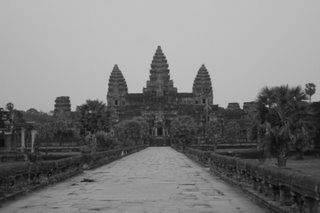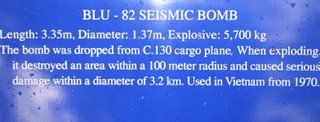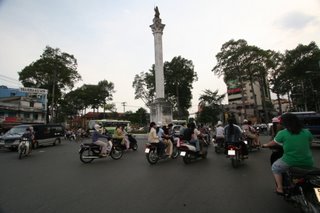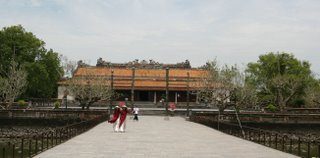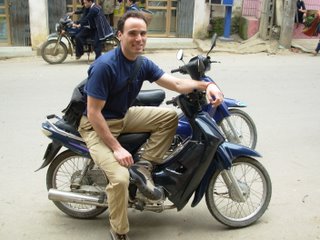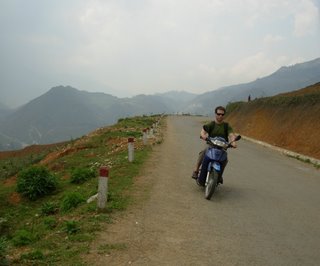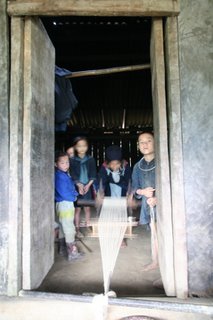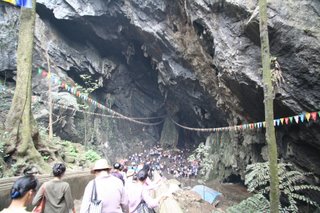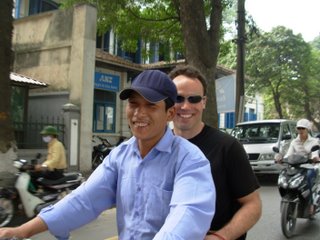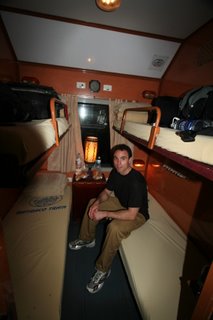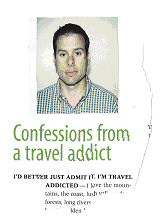I'm Getting Married!!!
in 2008 . . . at least according to Madame Har, Geomancy, Palmistry & Fortune Teller in the Central Market in Kuala Lumpur, or "KL" as it is referred to by locals. "Kuala" means bank or confluence (where the Klang and Gombak Rivers meet) and "Lumpur" means mud. Ever since I first traveled to Europe and watched the airport destination boards flip in Frankfurt or Paris, I was intrigued by the city's name. I couldn't tell you where it was or what it meant, but I wanted to visit, perhaps because I knew so little.
Twenty-five years later, I was wide eyed on the express airport train into mud bank city. The night before I met friends of friends in Singapore at a fashion show for a new urban clothing line. The show was held at a trendy nightclub that was bursting at the seams with people. For the first hour, the show was center stage, but soon after, the evening turned into a mega dance party. Champagne and shots were flowing like they were being poured from a tap, which was not necessarily a good thing, as my new friends hospitably urged me to drink. But the drinks were a bit rich for my tastes so I handed them to a nearby woman in our group who was more than happy to dispose of the excess. At 3 a.m. I was "fashioned out" and tired from touring all day in the heat. My cue to exit stage left was unmistakeable when one of the guys that had been encouraging everyone to drink lost his cookies (and I don't mean chocolate chip) in the bar, and worse yet, on my shoe.
Back on the train into KL, the brightly lit interior of the train made it difficult to see the scenery passing by. Out of the station, I grabbed a cab to my hotel situated only blocks from the famous Petronas Towers. Billed as the "tallest twin towers in the world", the 88 story towers were actually the tallest buldings in the world until 2003 when the 101 story "Taipei 101" was completed in Taiwan. Nearing the hotel, the commanding towers came into view, illuminating the night sky. They were not only tall, but also architecturally pleasing with a sky bridge connecting them at the 41 and 42 floors.
Traffic delayed my arrival into KL as Saturday night meant that the locals and visitors alike were out in full force. Before leaving for KL, I tried my luck surfing, couch surfing that is. An up and coming website, growing in popularity by the month, couchsurfing.com connects travelers around the world with other like minded people who are willing to let strangers crash on their couches when passing through their home country. For those who don't want to crash on a couch, there is the "have a coffee or drink" option, which was my choice for KL.
I couchsurfed Devid and Lu Yen, a married couple, living in KL. They were in their late 20s and early 30s, professional and had traveled and worked all over the world. Arriving at my hotel after 11 p.m., I phoned Lu Yen to apologize and said that maybe we could exchange e-mails on what to do in and around town since it was so late. She and David were heading to Penang, Malaysia the next day for the Labor Day weekend so would be unable to meet in the days following. But moments after hanging up, the hotel phone rang. It was Lu Yen saying not to be worried about the late hour and to meet them at Qba, a salsa bar at the Westin Hotel. I gave her a brief description of my hair color, height and told her I would be wearing a striped shirt.
Walking into the Westin lobby, it appeared the evening festivities were over, but that was only the tip of the lobby iceberg. Two stories below, Qba was just getting warmed up with a latin band belting salsa sounds into the cigar smoke filled room. A sea of bodies twisted and turned on the dance floor, while hundreds of others looked on or circled the bar. It was happening, but my couchsurfing experience was in jeopardy.
When I gave my physical description earlier, I did not foresee the likelihood that just about every other guy in the place would have stripes on his shirt, be about my height and have similar skin and hair tones. I did not know what Lu Yen and David were wearing or what they looked like, so I circled the bar once hoping to find someone else looking equally lost, or at least searching for someone else. Of course, that is usually everyone in a bar, and Qba was no exception. Like a page torn from the book of "As Luck Would Have It", I stood on the perimeter of the bar near the patio, scanning the crowd, catching the eye of one girl who seemed to be staring back. There was no one else with her and I since I was expecting a couple, I initially disqualified her. But as I continued to sift through the grooving crowd, I continued to glance in her direction, until finally the stares were awkwardly long. "Lu Yen?" I asked from my high position above the patio. "Yes, Todd?", she said smiling out of relief.

Lu Yen and I reintroduced ourselves and instantly hit it off. Moments later, Devid brought drinks from the bar and we were mired in conversation ranging from KL to lifestories to global politics. David is an expat from Italy, half-French and half-Italian in the wireless telecom business serving as CTO for a division of Ericson. Lu Yen is a native Malaysian of Chinese descent. It was social butterfly Lu Yen who joined the couch surfing website earlier in April. We were all first time couch surfers and the dividends were huge (for me at least) as the duo let the info on Malaysia flow. From KL day time activities to nightlife to other areas of interest in Malaysia, I left our meeting with two pages of insider tips. We capped the night off with a visit to a local hawker stall where Malay, Indian and Chinese food is served 24x7. By the time we left the stall at 3:30 a.m., cars were double parked in the adjacent lot and all of the seventy-five tables were taken.
Sunday morning was a slow starter for me after the late night. List of "To See" and "To Do" in hand I was out the door at noon. First stop was the ever popular, Petronas Towers. Standing before them, listening to other visitors talk about the "Twin Towers", I couldn't help but reflect on the twin towers I knew, the World Trade Center. Craning my neck to take in full scope of the buildings, I squinted to see if I could imagine the former World Trade Center instead. I recalled visiting the WTC observation deck and restaurant as a boy, in awe of the towers' massive scale and the expansive city views. Significantly different than the WTC, the Petronas Towers were designed by a US based Argentinian architect, who adopted an Islamic pattern based on an eight-sided star. Each tower has five tiers, representing the five pillars of Islam. Interesting to note, the Petronas Towers are physically taller (with the use of 241 foot spires) than the WTC, but the WTC had higher occupied floors.
 (Petronas Towers)
(Petronas Towers)
From Petronas Towers, I headed to the Merdeka Square, where on August 31, 1957, Malaysia claimed its independence from the British. Within blocks of the square, buildings of Victorian and Moorish architecture, Chinatown, the Central Market and three religious temples, a Buddhist monastery, a mosque and a Hindu temple can be found. While not quite as retentive as Singapore, KL is clean and efficient with an overhead monorail moving people across the sky from mall to mall. And a visit to the mall is as much a part of the cultural experience KL as a visit to the National History Museum.
As much as I avoid malls and shopping in general, shopping in KL is a mind blowing hyper sensory experience. Malls are connected to more malls as tens of thousands of people move about like ants on elevators, escalators and monorails. It's been a long time since I got lost in a department store staring through teary eyes looking for my Mom or Dad. But one hour in the Sungei Wang Mall and I was literally lost in the maze of two million square feet of retail. I was in retail hell, my worst nightmare.
I didn't know North from South, East from West, day from night. I might have tried to use "Famous Amos" as my landmark, if there weren't at least three Famous Amos' in the mall (I guess he's really famous in KL too). Or maybe I could have tried using one of the eight watch stores or twenty CD/DVD shops selling recent albums and titles for $1 each. But everything looked the same. Where is the floor that exits onto the street? On which side do I exit? Where the heck is a door? These were the questions going through my inquiring mind. Sure I wasn't solving a cure for global warming, but I reconfirmed my commitment to internet shopping.
Blurry eyed and stupefied, I stumpled down Jalan Sultan Ismail Road past five or six more malls to the retail safety of my hotel, which not surprisingly housed a few boutique shops selling overpriced local goods. Sunday evening was another night out on the town, this time solo, with lots of people watching, men, women, couples and "ladyboys" as they are referred to by the locals.
For about $8K US, men can go to Thailand and get the gender bending works, enslaving them to high heels, panty hose, lipstick, hormonal imbalances, and pricier hair cuts for life. At night, they stand in groups on street corners or bus stops licking their chops offering "massage" and "freaky time" to passing men. Taken in the right light, it's all fun and games, as long as caveat emptor is employed by the customers (including a big risk STD factor). For those who are unsuspecting, they will be in for the surprise of their lives, especially if one of their "dates" hasn't made the trip to Thailand yet. Some might call that getting more for your money (more bang for the buck?), while others would call it getting more than you bargained for.
Twenty-five years later, I was wide eyed on the express airport train into mud bank city. The night before I met friends of friends in Singapore at a fashion show for a new urban clothing line. The show was held at a trendy nightclub that was bursting at the seams with people. For the first hour, the show was center stage, but soon after, the evening turned into a mega dance party. Champagne and shots were flowing like they were being poured from a tap, which was not necessarily a good thing, as my new friends hospitably urged me to drink. But the drinks were a bit rich for my tastes so I handed them to a nearby woman in our group who was more than happy to dispose of the excess. At 3 a.m. I was "fashioned out" and tired from touring all day in the heat. My cue to exit stage left was unmistakeable when one of the guys that had been encouraging everyone to drink lost his cookies (and I don't mean chocolate chip) in the bar, and worse yet, on my shoe.
Back on the train into KL, the brightly lit interior of the train made it difficult to see the scenery passing by. Out of the station, I grabbed a cab to my hotel situated only blocks from the famous Petronas Towers. Billed as the "tallest twin towers in the world", the 88 story towers were actually the tallest buldings in the world until 2003 when the 101 story "Taipei 101" was completed in Taiwan. Nearing the hotel, the commanding towers came into view, illuminating the night sky. They were not only tall, but also architecturally pleasing with a sky bridge connecting them at the 41 and 42 floors.
Traffic delayed my arrival into KL as Saturday night meant that the locals and visitors alike were out in full force. Before leaving for KL, I tried my luck surfing, couch surfing that is. An up and coming website, growing in popularity by the month, couchsurfing.com connects travelers around the world with other like minded people who are willing to let strangers crash on their couches when passing through their home country. For those who don't want to crash on a couch, there is the "have a coffee or drink" option, which was my choice for KL.
I couchsurfed Devid and Lu Yen, a married couple, living in KL. They were in their late 20s and early 30s, professional and had traveled and worked all over the world. Arriving at my hotel after 11 p.m., I phoned Lu Yen to apologize and said that maybe we could exchange e-mails on what to do in and around town since it was so late. She and David were heading to Penang, Malaysia the next day for the Labor Day weekend so would be unable to meet in the days following. But moments after hanging up, the hotel phone rang. It was Lu Yen saying not to be worried about the late hour and to meet them at Qba, a salsa bar at the Westin Hotel. I gave her a brief description of my hair color, height and told her I would be wearing a striped shirt.
Walking into the Westin lobby, it appeared the evening festivities were over, but that was only the tip of the lobby iceberg. Two stories below, Qba was just getting warmed up with a latin band belting salsa sounds into the cigar smoke filled room. A sea of bodies twisted and turned on the dance floor, while hundreds of others looked on or circled the bar. It was happening, but my couchsurfing experience was in jeopardy.
When I gave my physical description earlier, I did not foresee the likelihood that just about every other guy in the place would have stripes on his shirt, be about my height and have similar skin and hair tones. I did not know what Lu Yen and David were wearing or what they looked like, so I circled the bar once hoping to find someone else looking equally lost, or at least searching for someone else. Of course, that is usually everyone in a bar, and Qba was no exception. Like a page torn from the book of "As Luck Would Have It", I stood on the perimeter of the bar near the patio, scanning the crowd, catching the eye of one girl who seemed to be staring back. There was no one else with her and I since I was expecting a couple, I initially disqualified her. But as I continued to sift through the grooving crowd, I continued to glance in her direction, until finally the stares were awkwardly long. "Lu Yen?" I asked from my high position above the patio. "Yes, Todd?", she said smiling out of relief.

Lu Yen and I reintroduced ourselves and instantly hit it off. Moments later, Devid brought drinks from the bar and we were mired in conversation ranging from KL to lifestories to global politics. David is an expat from Italy, half-French and half-Italian in the wireless telecom business serving as CTO for a division of Ericson. Lu Yen is a native Malaysian of Chinese descent. It was social butterfly Lu Yen who joined the couch surfing website earlier in April. We were all first time couch surfers and the dividends were huge (for me at least) as the duo let the info on Malaysia flow. From KL day time activities to nightlife to other areas of interest in Malaysia, I left our meeting with two pages of insider tips. We capped the night off with a visit to a local hawker stall where Malay, Indian and Chinese food is served 24x7. By the time we left the stall at 3:30 a.m., cars were double parked in the adjacent lot and all of the seventy-five tables were taken.
Sunday morning was a slow starter for me after the late night. List of "To See" and "To Do" in hand I was out the door at noon. First stop was the ever popular, Petronas Towers. Standing before them, listening to other visitors talk about the "Twin Towers", I couldn't help but reflect on the twin towers I knew, the World Trade Center. Craning my neck to take in full scope of the buildings, I squinted to see if I could imagine the former World Trade Center instead. I recalled visiting the WTC observation deck and restaurant as a boy, in awe of the towers' massive scale and the expansive city views. Significantly different than the WTC, the Petronas Towers were designed by a US based Argentinian architect, who adopted an Islamic pattern based on an eight-sided star. Each tower has five tiers, representing the five pillars of Islam. Interesting to note, the Petronas Towers are physically taller (with the use of 241 foot spires) than the WTC, but the WTC had higher occupied floors.
 (Petronas Towers)
(Petronas Towers)From Petronas Towers, I headed to the Merdeka Square, where on August 31, 1957, Malaysia claimed its independence from the British. Within blocks of the square, buildings of Victorian and Moorish architecture, Chinatown, the Central Market and three religious temples, a Buddhist monastery, a mosque and a Hindu temple can be found. While not quite as retentive as Singapore, KL is clean and efficient with an overhead monorail moving people across the sky from mall to mall. And a visit to the mall is as much a part of the cultural experience KL as a visit to the National History Museum.
As much as I avoid malls and shopping in general, shopping in KL is a mind blowing hyper sensory experience. Malls are connected to more malls as tens of thousands of people move about like ants on elevators, escalators and monorails. It's been a long time since I got lost in a department store staring through teary eyes looking for my Mom or Dad. But one hour in the Sungei Wang Mall and I was literally lost in the maze of two million square feet of retail. I was in retail hell, my worst nightmare.
I didn't know North from South, East from West, day from night. I might have tried to use "Famous Amos" as my landmark, if there weren't at least three Famous Amos' in the mall (I guess he's really famous in KL too). Or maybe I could have tried using one of the eight watch stores or twenty CD/DVD shops selling recent albums and titles for $1 each. But everything looked the same. Where is the floor that exits onto the street? On which side do I exit? Where the heck is a door? These were the questions going through my inquiring mind. Sure I wasn't solving a cure for global warming, but I reconfirmed my commitment to internet shopping.
Blurry eyed and stupefied, I stumpled down Jalan Sultan Ismail Road past five or six more malls to the retail safety of my hotel, which not surprisingly housed a few boutique shops selling overpriced local goods. Sunday evening was another night out on the town, this time solo, with lots of people watching, men, women, couples and "ladyboys" as they are referred to by the locals.
For about $8K US, men can go to Thailand and get the gender bending works, enslaving them to high heels, panty hose, lipstick, hormonal imbalances, and pricier hair cuts for life. At night, they stand in groups on street corners or bus stops licking their chops offering "massage" and "freaky time" to passing men. Taken in the right light, it's all fun and games, as long as caveat emptor is employed by the customers (including a big risk STD factor). For those who are unsuspecting, they will be in for the surprise of their lives, especially if one of their "dates" hasn't made the trip to Thailand yet. Some might call that getting more for your money (more bang for the buck?), while others would call it getting more than you bargained for.










